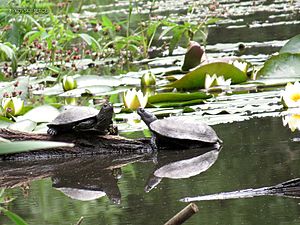Biocenosis facts for kids
Biocenosis is a fancy word for a community of living things that share the same home. Imagine all the plants, animals, fungi, and tiny microbes living together in one place, like a forest, a pond, or even a small patch of soil. This group of living things is called a biocenosis. The place they live, like the forest itself or the pond, is called a biotope. Together, the biocenosis (all the living things) and the biotope (their environment) form an ecosystem. The idea of biocenosis was first used by a scientist named Karl Möbius in 1877.
Contents
What is a Biocenosis?
A biocenosis is a group of different living things that live and interact in a specific area. Think of it as a neighborhood where all the plants, animals, and even tiny microbes depend on each other. This community is not just a random collection of species; they are connected through things like food chains, competition, and cooperation.
Living Together in a Biotope
The word "biocenosis" comes from Greek words meaning "life" (bio) and "community" (koinos). So, it literally means a "life community." This community lives in a specific physical environment called a biotope. The biotope includes non-living things like water, soil, sunlight, and air.
- Biocenosis: All the living things (plants, animals, fungi, bacteria).
- Biotope: The non-living environment (water, rocks, temperature, light).
When you put the biocenosis and the biotope together, you get an ecosystem. Every ecosystem, from a small puddle to a vast ocean, has both living and non-living parts that work together.
How Species Interact
Within a biocenosis, different species interact in many ways. These interactions are super important for the health of the community.
- Food Chains: Animals eat plants, and bigger animals eat smaller animals. This creates a flow of energy.
- Competition: Species might compete for the same resources, like food, water, or space.
- Cooperation: Sometimes, different species help each other. For example, bees help flowers by spreading pollen.
- Predation: One animal hunts and eats another.
- Symbiosis: Two different species live closely together, often helping each other.
These interactions keep the biocenosis balanced and healthy. If one part of the community changes, it can affect everything else.
Types of Biocenoses
Biocenoses can be found in all sorts of places, big or small. They are usually named after the main type of environment they are in.
Terrestrial Biocenoses
These are communities found on land.
- Forests: Trees, shrubs, mosses, deer, bears, birds, insects, and countless microbes.
- Deserts: Cacti, succulents, lizards, snakes, scorpions, and desert foxes.
- Grasslands: Grasses, wildflowers, zebras, lions, giraffes, and various rodents.
Aquatic Biocenoses
These are communities found in water.
- Ponds and Lakes: Water lilies, fish, frogs, insects, algae, and microscopic organisms.
- Rivers: Fish that can handle currents, aquatic plants, and insects.
- Oceans: Coral reefs, fish, sharks, whales, plankton, and deep-sea creatures.
Other Examples
Even smaller areas can have their own biocenosis.
- A single tree: It can host insects, birds, fungi, and bacteria.
- A rock pool: Small pools left by the tide can have tiny crabs, sea anemones, and algae.
Why Biocenosis is Important
Understanding biocenosis helps us see how all living things are connected. It shows us that every species, no matter how small, plays a role in its environment.
- Biodiversity: A healthy biocenosis usually has many different types of species. This variety is called biodiversity, and it makes the ecosystem stronger and more able to handle changes.
- Ecosystem Health: When a biocenosis is thriving, it means the ecosystem is working well. This is important for things like clean air, clean water, and healthy soil.
- Conservation: By studying biocenoses, scientists can learn how to protect endangered species and their habitats. If we lose one species, it can affect many others in the community.
Protecting biocenoses means protecting the amazing web of life on Earth.
Images for kids
-
The side of a tide pool showing sea stars (Dermasterias), sea anemones (Anthopleura) and sea sponges in Santa Cruz, California.
See also
 In Spanish: Biocenosis para niños
In Spanish: Biocenosis para niños



